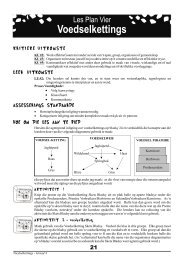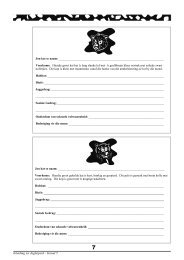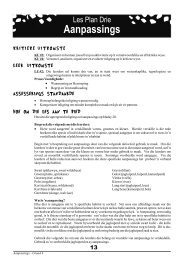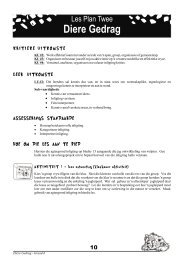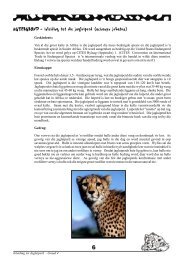Enrichment Suggestions for Captive-born, Hand-reared Jackals ...
Enrichment Suggestions for Captive-born, Hand-reared Jackals ...
Enrichment Suggestions for Captive-born, Hand-reared Jackals ...
You also want an ePaper? Increase the reach of your titles
YUMPU automatically turns print PDFs into web optimized ePapers that Google loves.
<strong>Enrichment</strong> <strong>Suggestions</strong> <strong>for</strong><br />
<strong>Captive</strong>-<strong>born</strong>, <strong>Hand</strong>-<strong>reared</strong><br />
<strong>Jackals</strong> Held in Captivity<br />
March 2010<br />
Deborah Wettlaufer and Liesl Smith<br />
Cheetah Outreach, Cape Town
<strong>Enrichment</strong><br />
Animals in captivity have a lot of time on their hands. Whereas wild animals would fill<br />
their time with activities such as hunting, searching <strong>for</strong> water or shelter, protecting their<br />
territory or searching <strong>for</strong> a mate, captive animals very often are provided all of these.<br />
This could potentially create problems such as boredom, frustration, stereotypic<br />
behaviors and stress. Undesirable behaviours include self-injurious actions like excessive<br />
grooming; abnormal behaviours such as regurgitation and reingestion; aggressive<br />
behaviours; and stereotypic behaviours. Behaviour is an important indication of welfare<br />
and enrichment enhances welfare of animals in captivity.<br />
<strong>Enrichment</strong> becomes a valuable and necessary practice by creating activities or providing<br />
stimulation that maximizes their quality of life and leads to inquisitive behavior.<br />
By enriching the animal’s environment, you empower the animal to have control over its<br />
environment and you give the animal a choice. Ignoring something is still a choice.<br />
Apart from the fact that enrichment provides methods of passing time, the added physical<br />
and mental stimulation might also cause better reproductive success and improve visitor’s<br />
experiences since the image of healthy and well-adjusted animals are promoted.<br />
Different <strong>for</strong>ms of enrichment used <strong>for</strong> captive animals today include:<br />
Enclosure Design<br />
Feeding or <strong>for</strong>aging<br />
Visual and Auditory<br />
Olfactory<br />
Novel Objects and Toys<br />
Exercise<br />
Social Interaction/Tactile<br />
Behavioural Conditioning<br />
<strong>Enrichment</strong> should be considered part of the daily husbandry routine at all responsible<br />
animal care facilities. An efficient enrichment programme can be more important than the<br />
size of the enclosures the animals are kept in. Environmental enrichment is not a luxury<br />
but a management tool.<br />
When developing an enrichment programme at a captive facility, the habits, behaviours<br />
and nature of the species, and the personality of the specific individual need to be<br />
considered.<br />
<strong>Enrichment</strong> suggestions <strong>for</strong> the jackals include the following:<br />
Produced by Cheetah Outreach (Last Updated: January 2013)<br />
Copyright © 2010-2013 Cheetah Outreach. All rights reserved.<br />
cheetah@intekom.co.za Http://www.cheetah.co.za<br />
Homes Provided by Heartland and Eikendal<br />
2
Enclosure Design<br />
Enclosures should be designed in order to address the needs <strong>for</strong> space, shade, shelter,<br />
privacy, stimulation, elevation and where appropriate, public viewing.<br />
When designing enclosure layouts the following should be incorporated:<br />
Shade<br />
Structures providing shade are an essential element in every enclosure.<br />
Shelter<br />
Waterproof huts not only serve as sleeping quarters and as hideaway, but also provide a<br />
lookout post to the animal.<br />
Produced by Cheetah Outreach (Last Updated: January 2013)<br />
Copyright © 2010-2013 Cheetah Outreach. All rights reserved.<br />
cheetah@intekom.co.za Http://www.cheetah.co.za<br />
Homes Provided by Heartland and Eikendal<br />
3
Water<br />
Water should be provided in solid, non-toxic containers. Containers should be placed in<br />
an easily accessible and shaded area. All water containers should be disinfected on a<br />
regular basis.<br />
Logs and Tree Branches<br />
Big logs can be packed at angles to one another. Branches can be placed against logs or<br />
other objects. Logs and branches provide areas to hide food in to encourage <strong>for</strong>aging as<br />
well as elevated areas to stand on.<br />
Plat<strong>for</strong>m<br />
Plat<strong>for</strong>ms provide an elevated place to view surroundings, provide a spot <strong>for</strong> sunning<br />
themselves and allow jackals to get off the ground when wet or muddy. We also often<br />
feed our jackals on top of the plat<strong>for</strong>m.<br />
When planning to build a plat<strong>for</strong>m the following should be considered:<br />
1) Non-toxic, safe materials should be used.<br />
2) The plat<strong>for</strong>m should be placed in such a position as not to allow any jumping or<br />
climbing over fences or other structures. The plat<strong>for</strong>ms are all erected on a flat,<br />
open section of grass, well away from any fences, huts or any other structure.<br />
3) There should be no protruding or sharp objects. There should be no objects that<br />
could cut, injure or get the animal entangled.<br />
Produced by Cheetah Outreach (Last Updated: January 2013)<br />
Copyright © 2010-2013 Cheetah Outreach. All rights reserved.<br />
cheetah@intekom.co.za Http://www.cheetah.co.za<br />
Homes Provided by Heartland and Eikendal<br />
4
Space<br />
<strong>Jackals</strong> are very active animals, normally moving at a trot and covering a lot of ground.<br />
They need adequate space <strong>for</strong> patrolling their territory and <strong>for</strong> exercise.<br />
Privacy<br />
<strong>Jackals</strong> are wary animals, even when used to human activity, and are very adept at<br />
concealing their presence under adverse conditions. Concealed private areas should be<br />
provided in all jackal enclosures. Logs, areas of shade cloth, palm fronds and other tree<br />
branches, reeds or simple bamboo walls can be used to provide these.<br />
Produced by Cheetah Outreach (Last Updated: January 2013)<br />
Copyright © 2010-2013 Cheetah Outreach. All rights reserved.<br />
cheetah@intekom.co.za Http://www.cheetah.co.za<br />
Homes Provided by Heartland and Eikendal<br />
5
Security<br />
<strong>Jackals</strong> are digging animals, often digging up insects and rodents. Jackal enclosures must<br />
be built to prevent digging out under fences. The jackal enclosure at Cheetah Outreach<br />
has fencing extended under the ground.<br />
Habitat Modifications<br />
Habitat modification by moving and changing exhibits inside the enclosures might<br />
provide stimulation. <strong>Jackals</strong> are very curious animals and will spend time sniffing any<br />
new object they encounter.<br />
Feeding<br />
Hiding or Scattering Food<br />
<strong>Jackals</strong> are <strong>for</strong>agers and hiding or scattering food in their enclosure encourages this<br />
natural feeding behaviour. At Cheetah Outreach meat or a mixture of meat, pellets and<br />
fruit soaked in blood is often hidden under branches or piles of logs, or scattered around<br />
the enclosure. Food is sometimes placed inside toilet paper rolls or papier-mâché balls to<br />
encourage jackals to retrieve food by either grabbing with teeth or paws.<br />
Produced by Cheetah Outreach (Last Updated: January 2013)<br />
Copyright © 2010-2013 Cheetah Outreach. All rights reserved.<br />
cheetah@intekom.co.za Http://www.cheetah.co.za<br />
Homes Provided by Heartland and Eikendal<br />
6
Whole or Partial Large Carcass Feeding<br />
Whole or partial carcasses can provide hours of stimulation and encourage natural<br />
scavenging and feeding behavior as well as social interaction, including posturing and<br />
dominance/submissive displays, between jackals. The origin and health status of the<br />
animal offered should be known and the session supervised.<br />
Whole Rabbits, Rats and Mice<br />
Whole carcass feeding provides much stimulation <strong>for</strong> jackals. Apart from roughage,<br />
whole rabbits and rats increase the length of feeding activity.<br />
Produced by Cheetah Outreach (Last Updated: January 2013)<br />
Copyright © 2010-2013 Cheetah Outreach. All rights reserved.<br />
cheetah@intekom.co.za Http://www.cheetah.co.za<br />
Homes Provided by Heartland and Eikendal<br />
7
Meat with Fur<br />
Sections of horsemeat with fur can be given. Apart from providing roughage, it also<br />
changes the texture of the food and increases the length of feeding activity.<br />
Whole or Partial Birds with Feathers<br />
In the wild, birds <strong>for</strong>m part of a jackal’s diet. Feeding with feathers encourages natural<br />
hunting behaviour as jackals carry prey around in their mouths, use threatening postures<br />
to guard it from each other and humans, and sometimes even pluck feathers from it.<br />
Birds with feathers also prolong feeding. Feeding should be supervised and remnants<br />
from the carcass removed. The origin and health status of the animal offered should be<br />
known.<br />
Day-old Chicks<br />
Dead baby chicks can supplement normal diet and add enrichment. Chicks should be deyolked<br />
prior to feeding.<br />
Produced by Cheetah Outreach (Last Updated: January 2013)<br />
Copyright © 2010-2013 Cheetah Outreach. All rights reserved.<br />
cheetah@intekom.co.za Http://www.cheetah.co.za<br />
Homes Provided by Heartland and Eikendal<br />
8
Eggs<br />
<strong>Jackals</strong> are omnivores and enjoy a varied diet. Eggs, both raw and hardboiled, provoke<br />
much curiosity as they try to break into them. The jackals at Cheetah Outreach carry<br />
them around in their mouths, and sometimes bury them.<br />
Live Insects<br />
<strong>Jackals</strong> are opportunistic hunters and scavengers, eating insects when other food is not<br />
available. Providing grubs or meal worms buried in dirt encourages them to sniff and<br />
probe <strong>for</strong> their food.<br />
Bloodsicles<br />
These are made by freezing blood and a few pieces of meat in small plastic containers<br />
and can be offered on warm days.<br />
Pumpkins<br />
Placing treats, such as pieces of meat, inside a hollowed-out pumpkin <strong>for</strong>ces jackals to try<br />
different retrieval techniques. Our jackals bite the pumpkin, try to pick it up and turn it<br />
over to <strong>for</strong>ce meat to fall out, or simply stick heads or paws in to get at the meat. They<br />
also will eat the seeds inside the pumpkin.<br />
Produced by Cheetah Outreach (Last Updated: January 2013)<br />
Copyright © 2010-2013 Cheetah Outreach. All rights reserved.<br />
cheetah@intekom.co.za Http://www.cheetah.co.za<br />
Homes Provided by Heartland and Eikendal<br />
9
Visual and Auditory<br />
Objects that provide visual and auditory stimulation include the following:<br />
Outside Stimuli<br />
Passing trains, motorbikes, running children, other animals, laborers, bicycles and<br />
wheelchairs. Having visual access to some of these not only provides mental stimulation<br />
but also increases activity as the jackals run back and <strong>for</strong>th in their enclosure to get a<br />
better look at outside activity or to hide from it.<br />
Other Animals<br />
Walking different types of animals on their leads past the jackals enclosure provides<br />
much interest and stimulation. The jackals become excited and active when another<br />
animal is walked by their enclosure or up to the fence.<br />
Olfactory<br />
<strong>Jackals</strong> have an acute sense of smell and much time is spent sniffing, rolling in and<br />
rubbing against objects.<br />
Animal Skins, Cow Hooves and Rawhide Objects<br />
Horse or donkey skin encourages much sniffing and chewing. Cow hooves and rawhide<br />
objects provide hours of chewing enjoyment. All skins and rawhide should only be given<br />
within 30 minutes of feeding as they may stimulate gastric juices and should accompany<br />
food.<br />
Produced by Cheetah Outreach (Last Updated: January 2013)<br />
Copyright © 2010-2013 Cheetah Outreach. All rights reserved.<br />
cheetah@intekom.co.za Http://www.cheetah.co.za<br />
Homes Provided by Heartland and Eikendal<br />
10
Animal Feces<br />
Animal feces, such as horse or elephant dung, results in much olfactory investigation.<br />
Our jackals sniff, roll, rub and urinate on the feces, returning to the dung over and over<br />
again. All feces must be sterilized be<strong>for</strong>e use.<br />
Moving Animals Between Enclosures<br />
The jackals can be moved into a <strong>for</strong>eign or lesser-known enclosure. If the enclosure is<br />
jackal-proof (underground fencing to keep them from digging out), they may be let off<br />
their leads. At Cheetah Outreach, the jackals are let off their leads in the large exercise<br />
enclosure but must be supervised to keep from digging out. Constant running or trotting<br />
around enclosure, and intense sniffing, investigating and rolling may be observed.<br />
Produced by Cheetah Outreach (Last Updated: January 2013)<br />
Copyright © 2010-2013 Cheetah Outreach. All rights reserved.<br />
cheetah@intekom.co.za Http://www.cheetah.co.za<br />
Homes Provided by Heartland and Eikendal<br />
11
Moving Objects Between Enclosures<br />
Some of the exhibits can be moved from one enclosure to another, such as a small dog<br />
house or piles of branches. The health status of all animals should always be known.<br />
Objects should never be moved from a sick or compromised animal to the enclosure of a<br />
healthy animal.<br />
Novel Objects<br />
<strong>Jackals</strong> are naturally curious animals so any novel objects that encourage them to search,<br />
sniff, probe with nose or paw, chew, bury or squabble over provides good enrichment.<br />
Novel objects are a good way of hiding food and encouraging <strong>for</strong>aging behaviours.<br />
Never leave any toys unsupervised with the animals.<br />
Papier-mâché Balls<br />
Balls with holes in them arouse the curiosity of jackals and encourage them to probe<br />
inside with noses or paws. Dry cat food in a papier-mâché ball makes a rattling noise and<br />
attracts their attention. Pieces of meat or fish inside encourages much sniffing. Once the<br />
jackals at Cheetah Outreach have eaten the treats inside, they spend time ripping apart the<br />
papier-mâché balls.<br />
Produced by Cheetah Outreach (Last Updated: January 2013)<br />
Copyright © 2010-2013 Cheetah Outreach. All rights reserved.<br />
cheetah@intekom.co.za Http://www.cheetah.co.za<br />
Homes Provided by Heartland and Eikendal<br />
12
Cardboard Boxes and Paper Towel Rolls<br />
Our jackals love chewing and destroying objects such as cardboard boxes and paper<br />
towel rolls. Putting some pieces of meat inside the box and soaking it in blood provides<br />
olfactory enrichment and challenges their cognitive abilities as the jackals smell the meat<br />
and blood, and have to figure out how to get inside the box to get the treats. Our jackals<br />
rip the box to shreds after eating all the meat.<br />
Rubber Kong Toys<br />
<strong>Jackals</strong> have very sharp teeth and tend to chew and rip up any object they are given.<br />
Only tough rubber toys, such as Kong toys, can stand up to a jackal’s sharp teeth. The<br />
jackals at Cheetah Outreach will carry rubber Kong toys around in their mouths, chew on<br />
them, squabble over them and often bury them.<br />
Small Balls, Gourds or Apples<br />
Throwing these objects will encourage jackals to chase after, carry around in their mouths<br />
and sometimes bury them. Only hard balls should be used as jackals are quick to destroy<br />
soft or rope toys, even with supervision.<br />
Produced by Cheetah Outreach (Last Updated: January 2013)<br />
Copyright © 2010-2013 Cheetah Outreach. All rights reserved.<br />
cheetah@intekom.co.za Http://www.cheetah.co.za<br />
Homes Provided by Heartland and Eikendal<br />
13
Exercise<br />
Exercise is essential and is a part of husbandry that cannot be compromised on. Not only<br />
does the activity help to maintain a healthy physical condition, but it also provides<br />
excellent mental stimulation. Exercise can be provided by the following means:<br />
Play<br />
Play is an important part of social interaction and the jackals at Cheetah Outreach spend a<br />
lot of time chasing, sparring and playing with each other. Play promotes activity and<br />
provides good exercise.<br />
Whip with Novelty Item<br />
A plastic bottle, soft toy or guinea fowl wing can be attached to a whip and used to<br />
encourage chasing by running up and down fence. The jackals at Cheetah Outreach<br />
respond best to feathers attached to a whip and try to grab or bite them through the fence.<br />
Because they are quick to destroy soft toys and feathers, it is best to run outside the<br />
enclosure with the whip.<br />
Walks<br />
Walks can provide the handler with many opportunities to enrich a jackal’s life. New and<br />
different environments can provide a variety of smells and sights to investigate. Not only<br />
do walks provide exercise to the jackals but they give them great opportunities to <strong>for</strong>age,<br />
and sniff, scent-mark and roll in new scents. The jackals at Cheetah Outreach may be let<br />
off their leads during walks in the big exercise enclosure, only under supervision, to give<br />
them the opportunity to run.<br />
Produced by Cheetah Outreach (Last Updated: January 2013)<br />
Copyright © 2010-2013 Cheetah Outreach. All rights reserved.<br />
cheetah@intekom.co.za Http://www.cheetah.co.za<br />
Homes Provided by Heartland and Eikendal<br />
14
Social interaction/Tactile<br />
Black-backed jackals are social animals with a monogamous relationship, so social<br />
interaction is essential to pair bonding and to individual well-being.<br />
Interaction with Staff/Volunteers<br />
For animals kept in captivity and thus exposed to people, it is to their benefit to view<br />
humans positively. This greatly minimizes one of the main stresses in captivity. Both<br />
jackals at Cheetah Outreach have been hand-raised by humans so enjoy attention from<br />
people on a daily basis.<br />
Interaction with Other <strong>Jackals</strong><br />
Black-backed jackals are monogamous and are among the few mammalian species in<br />
which the male and female mate <strong>for</strong> life. They do everything together: hunt; patrol,<br />
mark and defend their territory; and raise their young. They have a complex social<br />
structure with a well-developed communication system of ritualized dominance and<br />
submissive displays. Social interaction, including dominant and submissive posturing,<br />
grooming and play, is essential <strong>for</strong> the well-being of jackals in captivity.<br />
Produced by Cheetah Outreach (Last Updated: January 2013)<br />
Copyright © 2010-2013 Cheetah Outreach. All rights reserved.<br />
cheetah@intekom.co.za Http://www.cheetah.co.za<br />
Homes Provided by Heartland and Eikendal<br />
15
Interaction with Other Animals<br />
Seeing, smelling and interacting with other animals through a fence or at a distance can<br />
greatly enrich a captive jackal’s life. When encountering other animals, the jackals at<br />
Cheetah Outreach become very excited, crouching, wagging tails, rolling on the ground,<br />
rubbing against fences, and sticking muzzle or paws through the fence.<br />
This should be a positive experience <strong>for</strong> the animals and not lead to anxiety. Care should<br />
be taken to assess the demeanor and behaviour of all animals carefully.<br />
Behavioral Conditioning<br />
Behavioral conditioning is very important since it provides mental and intellectual<br />
stimulation. The level of conditioning depends on the individual.<br />
Lead Walking<br />
Lead walking begins at an early age in order <strong>for</strong> young animals to get accustomed to the<br />
restricted feeling of harness or collar and lead. Lead walking is important <strong>for</strong> all<br />
Produced by Cheetah Outreach (Last Updated: January 2013)<br />
Copyright © 2010-2013 Cheetah Outreach. All rights reserved.<br />
cheetah@intekom.co.za Http://www.cheetah.co.za<br />
Homes Provided by Heartland and Eikendal<br />
16
ambassador animals. With the jackals at Cheetah Outreach, it allows them to go on<br />
walks and explore different areas of the facility.<br />
Station Training<br />
Station training entails the use of verbal commands and hand signals to teach an animal<br />
to jump on an object and remain there until released with a reward. Station training can<br />
be used to facilitate feeding, slow down eating, control an animal while people are doing<br />
husbandry duties in an enclosure as well as provide mental stimulation. The jackals at<br />
Cheetah Outreach learn quickly, and use of station training makes feeding them easier<br />
and provides much stimulation to them.<br />
Produced by Cheetah Outreach (Last Updated: January 2013)<br />
Copyright © 2010-2013 Cheetah Outreach. All rights reserved.<br />
cheetah@intekom.co.za Http://www.cheetah.co.za<br />
Homes Provided by Heartland and Eikendal<br />
17



